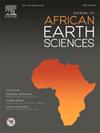Highly siderophile elements and mineral chemistry of chromitites from the Kırdağ ophiolite (NE Turkey): Constraints on genesis and subduction initiation
IF 2.2
4区 地球科学
Q2 GEOSCIENCES, MULTIDISCIPLINARY
引用次数: 0
Abstract
This study presents the first petrological and geochemical characterisation of chromitites from the mantle section of the Kırdağ ophiolite (NE Turkey), focusing on concentrations of highly siderophile elements (HSE; PGE and Au) and the mineralogical features of chromian spinel and olivine. Field and petrographic observations found that the chromitites occur as small bodies, predominantly with disseminated texture and less commonly as semi-massive structures, hosted within dunite lenses enclosed by harzburgitic mantle rocks. Chromian spinels exhibit Cr# values of 0.66–0.68 and Mg# values of 0.65–0.72, classifying the Kırdağ chromitites as intermediate-Cr type ophiolitic chromitites. The low TiO2 content (0.18–0.32 wt%) suggest derivation from melts transitional between boninite and island arc tholeiitic composition. Olivine occurs both as inclusions in spinel and within the interstitial matrix, with forsterite (Fo) contents higher in inclusions (96.21–97.18) compared to the matrix (94.25–94.68). The low Ca concentrations in olivine support formation from a highly magnesian melt interacting with a depleted mantle source. The chromitites display low total PGE concentration (73–153 ppb), relative enrichment in Ir-group (IPGE) over Pd-group (PPGE), and low Au content (<5–8 ppb), consistent with typical ophiolitic chromitite signatures. Pd/Ir ratios (0.77–2.33) and Pt anomalies (Pt/Pt∗ = 0.24–0.76) indicate that partial melting was the primary control on PGE distribution, although increasing Pd/Ir ratios suggest a minor role for magmatic fractionation. The estimated parental magma composition, characterised by low TiO2 (0.29–0.44 wt%), moderate Al2O3 (13.52–13.80 wt%), and FeO/MgO ratios (0.82–1.02), points to arc-related affinity. These results suggest that the Kırdağ chromitites formed during the early stages of subduction initiation, in a supra-subduction zone forearc setting, from a progressively evolving mantle source.
土耳其东北部Kırdağ蛇绿岩中高亲铁元素和铬铁矿矿物化学:对成因和俯冲起始的制约
本研究首次对Kırdağ蛇绿岩(土耳其东北部)地幔剖面的铬铁矿进行了岩石学和地球化学表征,重点研究了高亲铁元素(HSE;铬尖晶石和橄榄石的矿物学特征。现场和岩石学观察发现,铬铁矿以小体形式出现,主要呈浸染状结构,较少见的是半块状结构,赋存于由黑刺质地幔岩石包围的灰质透镜体中。铬尖晶石Cr#值为0.66 ~ 0.68,Mg#值为0.65 ~ 0.72,Kırdağ铬铁矿属中铬型蛇绿质铬铁矿。较低的TiO2含量(0.18-0.32 wt%)表明其来源于博云石和岛弧拉斑岩成分之间的熔体过渡。橄榄石以包裹体形式存在于尖晶石和基质中,包裹体中forsterite (Fo)的含量(96.21 ~ 97.18)高于基质(94.25 ~ 94.68)。橄榄石中的低钙含量支持了高镁熔体与枯竭地幔源相互作用形成的地层。该铬铁矿的PGE总浓度较低(73 ~ 153 ppb), Ir-group (IPGE)相对富集于Pd-group (PPGE), Au含量较低(<5 ~ 8 ppb),具有典型的蛇绿质铬铁矿特征。Pd/Ir比值(0.77 ~ 2.33)和Pt异常(Pt/Pt∗= 0.24 ~ 0.76)表明,部分熔融是控制PGE分布的主要因素,但增大的Pd/Ir比值表明岩浆分选作用较小。估计母岩浆组成特征为低TiO2 (0.29-0.44 wt%),中等Al2O3 (13.52-13.80 wt%), FeO/MgO比值(0.82-1.02),表明与弧相关的亲和关系。这些结果表明,Kırdağ铬铁矿形成于俯冲起始的早期阶段,在超俯冲带弧前环境中,来自一个逐渐演化的地幔源。
本文章由计算机程序翻译,如有差异,请以英文原文为准。
求助全文
约1分钟内获得全文
求助全文
来源期刊

Journal of African Earth Sciences
地学-地球科学综合
CiteScore
4.70
自引率
4.30%
发文量
240
审稿时长
12 months
期刊介绍:
The Journal of African Earth Sciences sees itself as the prime geological journal for all aspects of the Earth Sciences about the African plate. Papers dealing with peripheral areas are welcome if they demonstrate a tight link with Africa.
The Journal publishes high quality, peer-reviewed scientific papers. It is devoted primarily to research papers but short communications relating to new developments of broad interest, reviews and book reviews will also be considered. Papers must have international appeal and should present work of more regional than local significance and dealing with well identified and justified scientific questions. Specialised technical papers, analytical or exploration reports must be avoided. Papers on applied geology should preferably be linked to such core disciplines and must be addressed to a more general geoscientific audience.
 求助内容:
求助内容: 应助结果提醒方式:
应助结果提醒方式:


